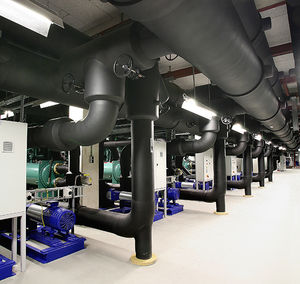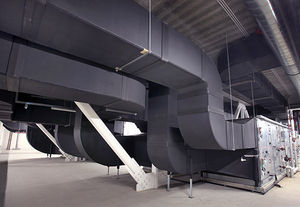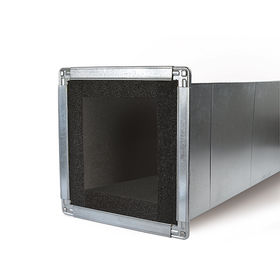 In the HVAC industry, most sound or noise is generated via rotating equipment and air and fluid movement through ducts and pipes. This movement creates vibration, sound, or noise. Vibration in its simplest form can be considered an oscillation or repetitive motion of an object around an equilibrium position. In the HVAC industry, sound is usually generated by some form of vibration from equipment. Although sound is not present without vibration, there can be vibration without sound noticeable to the human ear. Therefore, the best way to reduce sound is to limit the vibration produced by mechanical equipment. Examples are rotating shafts or gears, thermal processes such as combustion, or fluid dynamic means such as airflow through a duct or fan interactions with air.
In the HVAC industry, most sound or noise is generated via rotating equipment and air and fluid movement through ducts and pipes. This movement creates vibration, sound, or noise. Vibration in its simplest form can be considered an oscillation or repetitive motion of an object around an equilibrium position. In the HVAC industry, sound is usually generated by some form of vibration from equipment. Although sound is not present without vibration, there can be vibration without sound noticeable to the human ear. Therefore, the best way to reduce sound is to limit the vibration produced by mechanical equipment. Examples are rotating shafts or gears, thermal processes such as combustion, or fluid dynamic means such as airflow through a duct or fan interactions with air.
Vibration and Sound Issue Solutions
 Control of HVAC system sound and vibration are of equal importance, but measurement of vibration is often not necessary to determine sources or transmission paths of unwanted sound or noise. Because vibration is the source of noise from HVAC systems, management of those conditions is imperative to a quiet design. System design that neglects to properly address vibration may result in malfunctioning components, noise, and, in some cases, catastrophic failure.
Control of HVAC system sound and vibration are of equal importance, but measurement of vibration is often not necessary to determine sources or transmission paths of unwanted sound or noise. Because vibration is the source of noise from HVAC systems, management of those conditions is imperative to a quiet design. System design that neglects to properly address vibration may result in malfunctioning components, noise, and, in some cases, catastrophic failure.
There are two facets of vibration management: isolation and damping. Isolation is the prevention of vibration from entering the system and dissipating it by changing kinetic energy of vibration into a different form of energy, such as heat. Vibration isolation systems for mechanical components require some amount of damping. Damping dissipates mechanical energy from the system and attenuates vibrations more quickly. Without damping, these systems may vibrate for some time before coming to rest. The fluid in automotive shock absorbers is a kind of damper, as is the inherent damping in elastomeric (rubber) equipment mounts, component foams or foam insulation products.
 The acoustic properties of foam help mitigate both structure-borne and airborne noise, improving indoor environmental quality (IEQ) in all types of occupied spaces. All of the AP ArmaFlex® closed-cell foam and AP CoilFlex® conformable foam insulation products offer acoustical performance along with the thermal efficiency and energy savings they provide. Whether used in HVAC systems to quiet low-frequency structure-borne or airborne noise or to damp vibrations which cause ambient noise, Armacell foam insulation makes a real difference in any HVAC mechanical environment.
The acoustic properties of foam help mitigate both structure-borne and airborne noise, improving indoor environmental quality (IEQ) in all types of occupied spaces. All of the AP ArmaFlex® closed-cell foam and AP CoilFlex® conformable foam insulation products offer acoustical performance along with the thermal efficiency and energy savings they provide. Whether used in HVAC systems to quiet low-frequency structure-borne or airborne noise or to damp vibrations which cause ambient noise, Armacell foam insulation makes a real difference in any HVAC mechanical environment.
To read the full article from Consulting - Specifying Engineer Magazine here.
